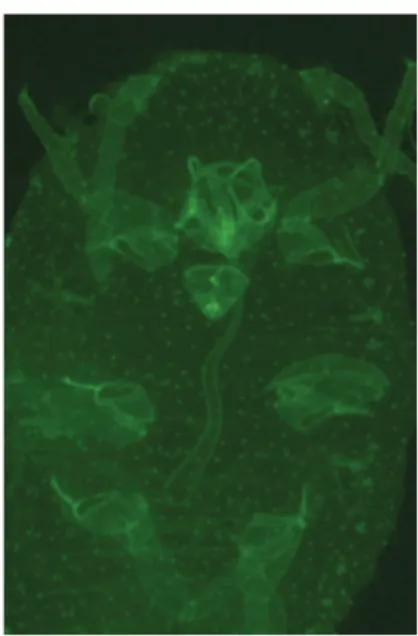HAL Id: hal-01203827
https://hal.archives-ouvertes.fr/hal-01203827
Submitted on 3 Jun 2020
HAL is a multi-disciplinary open access
archive for the deposit and dissemination of sci-entific research documents, whether they are pub-lished or not. The documents may come from teaching and research institutions in France or abroad, or from public or private research centers.
L’archive ouverte pluridisciplinaire HAL, est destinée au dépôt et à la diffusion de documents scientifiques de niveau recherche, publiés ou non, émanant des établissements d’enseignement et de recherche français ou étrangers, des laboratoires publics ou privés.
Mouthparts anatomy and transmission studies of
Grapevine leafroll-associated virus 1 and Grapevine
virus A by the mealybug Phenacoccus aceris
Antoine Alliaume, Catherine Reinbold, Maryline Uzest-Bonhomme, Monique
Beuve, Gerard Hommay, Olivier Lemaire, Etienne Herrbach
To cite this version:
Antoine Alliaume, Catherine Reinbold, Maryline Uzest-Bonhomme, Monique Beuve, Gerard Hommay, et al.. Mouthparts anatomy and transmission studies of Grapevine leafroll-associated virus 1 and Grapevine virus A by the mealybug Phenacoccus aceris. 18. Congress of the International Council for the Study of Virus and Virus-like Diseases of the Grapevine (ICVG), Sep 2015, Ankara, Turkey. 2015. �hal-01203827�
110 ICVG 2015 Abstracts
Proceedings of the 18
thCongress of ICVG, Ankara, TURKEY | 7-11 September 2015
OP 44 - Transmission studies of the Grapevine leafroll-associated virus 1 and
the Grapevine virus A by the mealybug Phenacoccus aceris.
Alliaume A.1*, Reinbold C.1, Uzest M.2, Beuve M.1, Hommay G.1, Lemaire O.1 & Herrbach E.1
1 UMR INRA-UDS 1131, Santé de la Vigne et Qualité du Vin, 28 rue de Herrlisheim, 68021 Colmar. France 2 INRA UMR-BGPI TA A-54/K, Campus International de Baillarguet, 34398 Montpellier Cedex 5. France
*Corresponding author : antoine.alliaume@colmar.inra.fr
INTRODUCTION
Grape production faces many severe viral, bacterial and fungal diseases, among which leafroll is one of the most devastating worldwide. Leafroll disease can be caused by several viruses belonging to the Closteroviridae family (GLRaV-1, -2, -3, -4 and -4-like). While GLRaV2 (genus Closterovirus) has no known vector and to our knowledge does not spread naturally in vineyards, the other three ones (Ampelovirus) are specifically transmitted by mealybugs (Pseudococcidae) and soft scales (Coccidae) and thus prone to be efficiently dispersed within and between vineyards (Sforza et al., 2003 ; Le Maguet et al., 2013). GLRaV-1 and GVA have flexuous virions of ca. 2000 nm and 800 nmcomposed of positive ssRNAs of 18,7 Kb and 7,5 Kb, respectively.
GLRaV-1 and GVA are restricted to vascular tissues of host plants and are frequently present in co-infection in grapevine. Their transmission by mealybugs has been shown to comply the criteria of a “semi-persistent and non-circulative” mode (Tsai et al., 2008).The mealybug Phenacoccus aceris has been shown to transmit very efficiently ampeloviruses and
vitiviruses (Le Maguet et al., 2012), but neither the biological parameters of the transmission, nor the precise location of virions specific retention within the vector are known so far.
MATERIALS AND METHODS
To address these questions, mouthparts anatomy of the vector P. aceris was described using scanning electron microscopy (SEM) and transmission electronic microscopy (TEM) techniques. Transmission tests from infected to healthy plants were developped to determine the biological parameters of the transmission, such as the minimum acquisition and inoculation access periods of the viruses by mealybugs, and the maximum retention time within the vector. Fluorescent labelling by successive membrane feedings were used to locate the precise zone of particles retention. Virions were purified following the protocol described by Gugerli et al. (1984) and hybridization with specific primary (BioReba) then secondary (ALEXA Fluor 488 & 568) antibodies was used to label the virions particles within the mealybug.
RESULTS AND DISCUSSION
Phenacoccus aceris mouthparts anatomy appears to be close to those of other sap-sucking insects.
Mouthparts are composed of a clypeus, a labium and the stylet fascicle. The three-segmented labium bearing some mechanosensory hair-like sensilla, show a labial groove on its anterior surface, enclosing the stylet fascicle. The stylet bundle is needle-like and composed of two distinct mandibular and maxillary stylets.
Experiments to determine the biological parameters of the transmission showed that P. aceris is able to acquire and transmit both viruses in a very short time (1 h acquisition and inoculation time). However, the transmission efficiency increase in time as previously shown for the GLRaV-3 transmission by Planococcus ficus (Tsai et al., 2008).
The “semi persistent and non circulative” transmission mode of the GLRaV-1 and the GVA implies a virion retention on ectodermic structures, such as the stylet fascicle and/or the foregut of the insect.
ACKNOWLEDGEMENTS
Authors thank Jean Sébastien Reynard and Nathalie Dubuis (Agroscope Changins, Switzerland) for the virions purification techniques and INRA, CIVA (Comité Interprofessionel des Vins d’Alsace), BIVB (Bureau Interprofessionel des Vins de Bourgogne) and CIVC (Comité Interprofessionel du Vin de Champagne) for supporting this study.
ICVG 2015 Abstracts 111
Proceedings of the 18
thCongress of ICVG, Ankara, TURKEY | 7-11 September 2015
REFERENCES
Gugerli, P., Brugger, J.J., & Bovey, R. 1984. L’enroulement de la vigne : mise en évidence de particules virales et développement d’une méthode immuno-enzymatique pour le diagnostic rapide (Grapevine leafroll: presence of virus particles and development of an immuno-enzyme method for diagnosis and detection). Rev. Suisse Viticult. Arboricult. Hort., 16 : 299-304.
Le Maguet, J., Beuve, M., Herrbach, E., & Lemaire, O. 2012. Transmission of six ampeloviruses and two vitiviruses to grapevine by Phenacoccus
aceris. Phytopathology, 102 : 717–23.
Le Maguet J., Fuchs, J.J., Beuve M., Chadoeuf J., Herrbach E., & Lemaire O. 2013. The role of the mealybug Phenacoccus aceris in the epidemic of Grapevine leafroll-associated virus-1 (GLRaV-1) in two French vineyards. Eur. J. Plant Pathol., 135 : 415–427.
Sforza, R., Boudon-Padieu, E., & Greif, C. 2003. New Mealybug Species Vectoring Grapevine Leafroll-Associated Viruses-1 and -3 (GLRaV-1 and -3). Eur. J. Plant Pathol., 109 : 975–981.
Tsai, C.W., Chau, J., Fernandez, L., Bosco, D., Daane, K.M., & Almeida., R.P.P. 2008. Transmission of Grapevine leafroll-associated virus 3 by the Vine Mealybug (Planococcus ficus). Phytopathology 100 : 830–834.
Figure 1. Tip of a P. aceris maxillary
